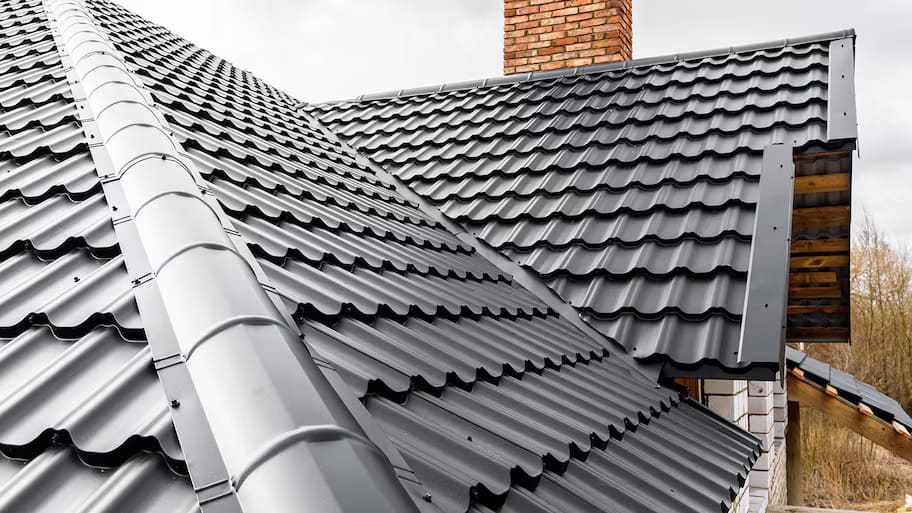In an era where energy efficiency and sustainability are increasingly prioritized, the type of roofing you choose for your home or building can significantly impact both your energy consumption and the structure’s longevity. The roof, often overlooked, plays a critical role in protecting the building from environmental elements while also contributing to the overall energy efficiency. This article delves into the top roof types known for their energy efficiency and durability, providing you with essential insights to make an informed decision.
1. Metal Roofing
Energy Efficiency: Metal roofs are highly reflective, which means they can reflect a significant portion of the sun’s rays. This reflective property helps in reducing the amount of heat absorbed by the building, thereby lowering cooling costs in the summer. Some metal roofs are also coated with special pigments that enhance their reflective capabilities, further boosting energy savings.
Durability: Metal roofing is renowned for its durability. It can withstand extreme weather conditions, including heavy snow, rain, and strong winds. Metal roofs are also resistant to fire, rot, and insect damage. With proper maintenance, a metal roof can last between 40 to 70 years, making it a long-term investment for any property owner.
2. Asphalt Shingles
Energy Efficiency: Asphalt shingles are a popular choice due to their affordability and ease of installation. They are available in various colors, including lighter shades that can reflect sunlight and reduce heat absorption. Additionally, some asphalt shingles come with energy-efficient features like cool roof technology, which enhances their reflective properties and contributes to lower energy bills.
Durability: Asphalt shingles typically last between 15 to 30 years, depending on the quality of the material and the local climate. They are relatively durable and can handle moderate weather conditions, although they might not be the best choice for areas prone to extreme weather events. Regular maintenance, such as inspecting for and replacing damaged shingles, can extend their lifespan.
3. Clay and Concrete Tiles
Energy Efficiency: Clay and concrete tiles have excellent thermal properties. They provide natural insulation, which helps keep buildings cooler in the summer and warmer in the winter. The thermal mass of these tiles allows them to absorb and slowly release heat, contributing to a more stable indoor temperature and reduced reliance on heating and cooling systems.
Durability: Both clay and concrete tiles are incredibly durable and can last up to 50 years or more with proper maintenance. They are resistant to fire, rot, and insects, and can withstand harsh weather conditions, including high winds and hail. However, they are heavier than other roofing materials, which means the building’s structure must be able to support the additional weight.
4. Slate Roofing
Energy Efficiency: Slate is a natural stone with exceptional thermal properties. It provides excellent insulation, helping to maintain a consistent indoor temperature. Slate roofs can effectively reduce heat transfer, making them an energy-efficient option for both hot and cold climates.
Durability: Slate roofing is one of the most durable options available, with a lifespan that can exceed 100 years. It is highly resistant to fire, water, and temperature fluctuations. Despite its durability, slate is also one of the more expensive roofing materials and requires professional installation due to its weight and fragility.
5. Green Roofs
Energy Efficiency: Green roofs, or living roofs, are covered with vegetation and soil, providing natural insulation and reducing the heat island effect in urban areas. They help lower indoor temperatures in the summer and provide additional insulation in the winter, which can significantly reduce energy costs. Green roofs also improve air quality and reduce stormwater runoff, contributing to a more sustainable environment.
Durability: When properly installed and maintained, green roofs can last up to 50 years. The plants and soil layer protect the underlying roof materials from UV radiation, temperature extremes, and mechanical damage. However, green roofs require regular maintenance to ensure the health of the vegetation and the integrity of the roofing system.
6. Solar Shingles
Energy Efficiency: Solar shingles, also known as photovoltaic shingles, combine the benefits of solar panels with the aesthetic appeal of traditional roofing materials. They generate electricity by harnessing sunlight, which can significantly reduce or even eliminate your energy bills. Solar shingles are designed to integrate seamlessly with existing roofing materials, providing both energy generation and traditional roofing functions.
Durability: Solar shingles are designe to withstand various weather conditions and have a lifespan comparable to traditional roofing materials, typically around 25 to 30 years. They are durable and resistant to fire, water, and wind. However, their initial cost can be higher compare to other roofing options, but the long-term energy savings can offset this investment.
Conclusion
Choosing the right roofing material involves balancing energy efficiency, durability, cost, and aesthetic preferences. Metal roofing offers excellent durability and energy efficiency, making it a long-term investment. Asphalt shingles provide an affordable option with decent energy savings and moderate durability. Clay and concrete tiles, as well as slate roofing, offer exceptional durability and thermal properties but come with higher initial costs and weight considerations. Green roofs contribute to sustainability and energy efficiency, while solar shingles provide the dual benefits of energy generation and roofing.


